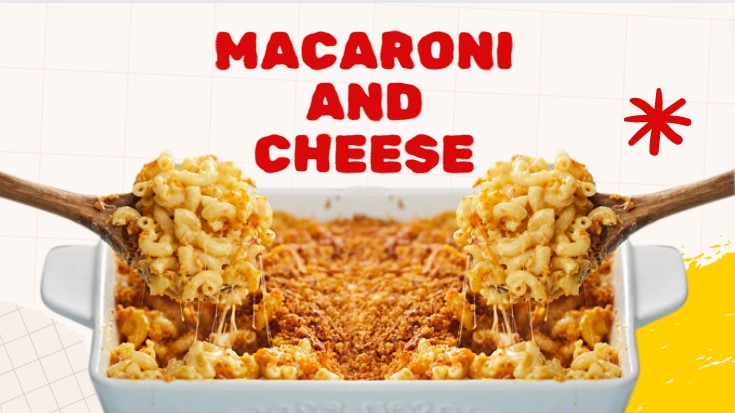Discover the best mac and cheese recipes! From classic creamy versions to gourmet twists, learn how to make this ultimate comfort food at home with ease
Ultimate Guide to Making the Perfect Mac and Cheese
Mac and cheese is more than just a dish; it’s a warm hug on a plate, a comforting classic that brings joy to many. Macintosh and cheddar is your go-to recipe.
It works for a simple weeknight meal or to impress at a dinner party. This guide will cover the history of this beloved dish. We’ll list the essential ingredients.
Then, we’ll provide a step-by-step recipe for the classic version. Lastly, we’ll share some creative variations to spice things up. Let’s dive in!
A Brief History of Mac and Cheese
Macaroni and cheese has a rich history that dates back to ancient times. The idea of mixing pasta with cheese dates to medieval Europe.
There, they made dishes similar to today’s mac and cheese. However, it wasn’t until the dish crossed the Atlantic to America that it became a staple in our cuisine.
In the 18th century, Thomas Jefferson brought macaroni and cheese to the U.S. after trying it in Europe.
His love for the dish led him to serve it at a state dinner, introducing it to a broader American audience.
It is enjoyed in various forms, from simple homemade versions to gourmet creations.
Essential Ingredients for Classic Mac and Cheese
Creating the perfect mac and cheese starts with the right ingredients. Here’s what you’ll need:
- Pasta: Use elbow macaroni, the traditional choice. Or, try other shapes like shells or cavatappi for a fun twist.
- Cheese: The cheese sauce is the heart of the dish. Cheddar is the classic choice. It has a sharp flavor and melts well. You can mix in other cheeses, like Gruyère or Monterey Jack, for a more complex taste.
- Milk and Cream: These are essential for creating a smooth, creamy sauce. Whole milk and heavy cream work best to achieve that rich texture.
- Butter and Flour: To thicken the sauce, you’ll start by making a roux with butter and flour. This creates a base that will blend seamlessly with the cheese and dairy.
- Seasonings: Salt, pepper, and mustard powder are standard seasonings. You can also add a pinch of nutmeg or cayenne pepper for extra depth.
Step-by-Step Guide to Making Classic Mac and Cheese
1. Cook the Pasta
Start by bringing a large pot of salted water to a boil. Be sure not to overcook it, as the pasta will continue to cook when baked. Drain and set aside.
2. Make the Cheese Sauce
Once melted, whisk in 1/4 cup of flour and cook for about 1-2 minutes to form a roux.
Slowly whisk in 2 cups of milk and 1 cup of heavy cream, making sure there are no lumps. Proceed to cook and speed until the blend begins to thicken.
Next, add 2 cups of shredded cheddar cheese (and any other cheeses, if using) to the sauce. Stir until it’s melted and smooth. Season with salt, pepper, and 1 teaspoon of mustard powder. Taste and adjust the seasonings if needed.
4. Bake (Optional)
For a classic baked mac and cheese, preheat your oven to 350°F (175°C). Transfer the pasta and cheese mixture to a baking dish. If desired, top with a mixture of breadcrumbs and melted butter for a crunchy topping.
Creative Variations

While classic mac and cheese is always a winner, don’t be afraid to get creative. Here are some fun variations to try:
- Baked Mac and Cheese: Before baking, top it with buttered, seasoned breadcrumbs. It will make a crispy, golden crust.
- Gourmet Mac and Cheese: Use truffle oil, lobster, or wild mushrooms for a fancy twist.
- Healthy Mac and Cheese: Use whole wheat pasta and add vegetables like broccoli or spinach. You can also make a lighter cheese sauce using lower-fat dairy options.
- Spicy Mac and Cheese: Spice things up with the addition of jalapeños, hot sauce, or a sprinkle of cayenne pepper.
Common Mistakes to Avoid
To ensure your mac and cheese turns out perfectly every time, keep these tips in mind:
- Overcooking the Pasta: Make sure to cook the pasta just until al dente. It will continue to cook as it bakes with the cheese sauce.
- Using Pre-Shredded Cheese: Pre-shredded cheese has anti-caking agents. They can affect the smoothness of your sauce. Shred your cheese from a block for the best results.
- Not Seasoning Enough: Don’t be shy with the seasonings. Taste your cheese sauce before combining it with the pasta and adjust as needed.
- Skipping the Roux: The roux is crucial for thickening the cheese sauce. Don’t skip this step, and make sure to cook it long enough to remove the raw flour taste.
Pairing Suggestions
Mac and cheese pairs well with a variety of side dishes and beverages. Here are some ideas:
- Side Dishes: Serve with a salad, steamed veggies, or roasted Brussels sprouts. They will balance the dish’s richness.
- Beverages: Enjoy with a crisp white wine, like Sauvignon Blanc, or a light beer. For non-alcoholic options, try sparkling water or a refreshing iced tea.
Frequently Asked Questions
Can I freeze mac and cheese? Yes, you can freeze mac and cheese.
What’s the best way to reheat leftovers? Reheat leftovers in the oven to maintain the creamy texture. Cover the dish with foil to prevent drying out and bake at 350°F (175°C) until heated through. You can also reheat individual portions in the microwave, though they may not be as crispy.
Ensure the cheese is fully melted and the sauce is smooth before combining it with the pasta. Use freshly grated cheese. Avoid overheating the sauce. This can help prevent a grainy texture.
Mac and cheese is a timeless comfort food that’s easy to make and incredibly versatile. This dish will please, whether you stick to the classic recipe or try gourmet variations. Follow this guide to create the perfect mac and cheese and enjoy it with family and friends. Don’t forget to share your own mac and cheese tips and favorite recipes in the comments below!

is a digital marketing consultant with a passion for advanced living, is the man behind this blog, where he shares his love for all things kitchen and culinary trends to help you elevate your cooking experience.



